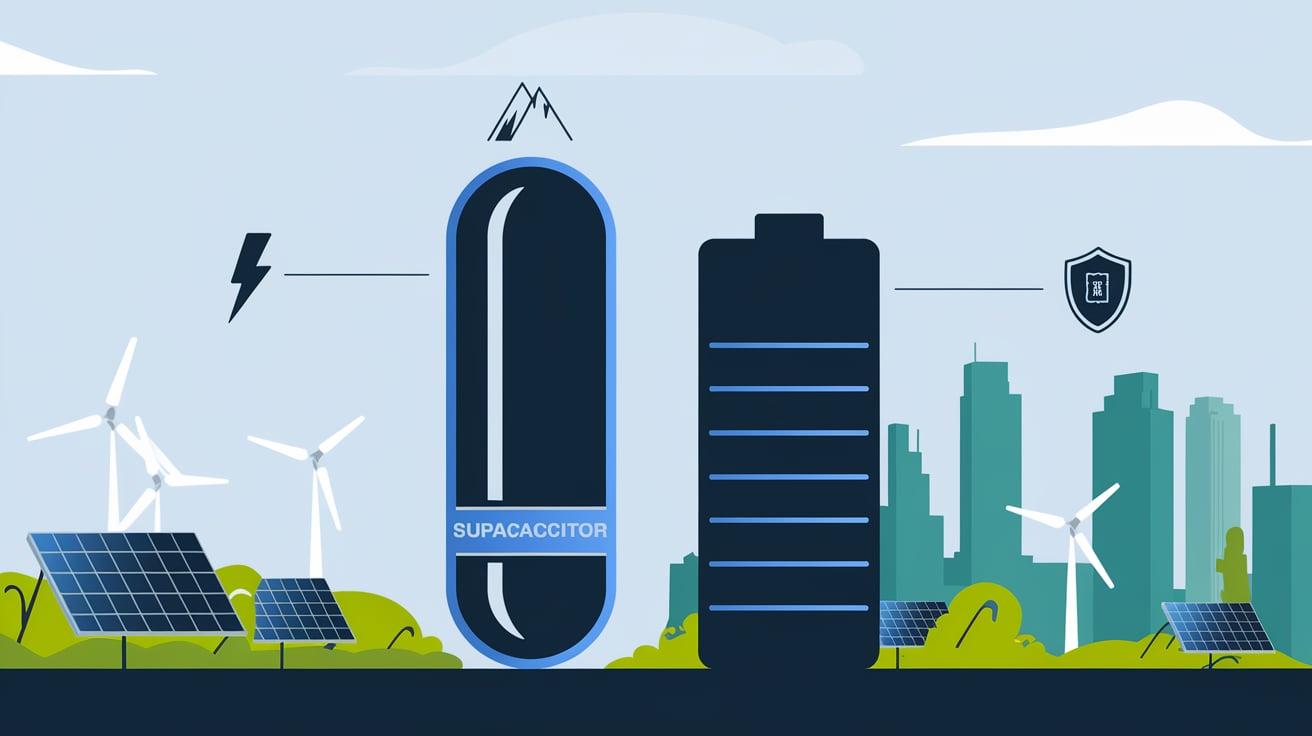Exploring the Future of Energy Storage: Batteries and Supercapacitors

In an era dominated by technological innovation, energy storage solutions have become the backbone of many industries, from electric vehicles to renewable energy systems. Batteries and supercapacitors play pivotal roles in this landscape, each offering distinct advantages and applications. But what sets these two apart, and how do they complement each other? Let’s delve into the differences and explore their combined potential.
Understanding Batteries and Supercapacitors
What Are Batteries?
Batteries are electrochemical devices that store energy in chemical form and convert it into electrical energy when required. They are widely used in various applications, from powering small electronic devices to running electric vehicles and storing renewable energy.
Key Features:
- Energy Density: Batteries have high energy density, making them suitable for long-term energy storage.
- Discharge Rates: Batteries release energy at a steady pace, ideal for continuous power supply.
- Chemistry Variations: Common types include lithium-ion, lead-acid, and nickel-metal hydride.
What Are Supercapacitors?
Supercapacitors, also known as ultracapacitors, store energy in an electric field rather than relying on chemical reactions. They excel in delivering quick bursts of energy and are used in applications requiring rapid charge and discharge cycles.
Key Features:
- Power Density: Supercapacitors offer higher power density, allowing them to charge and discharge rapidly.
- Longevity: They have a longer lifecycle compared to traditional batteries.
- Temperature Tolerance: Supercapacitors perform well in extreme temperatures, making them suitable for industrial and automotive applications.
Batteries vs. Supercapacitors: Key Differences
While both batteries and supercapacitors are energy storage devices, their unique characteristics make them suitable for different scenarios.
| Feature | Batteries | Supercapacitors |
|---|---|---|
| Energy Density | High | Low |
| Power Density | Low | High |
| Charge/Discharge | Slower | Faster |
| Lifespan | Shorter (500-1,500 cycles) | Longer (1 million+ cycles) |
| Applications | Long-term energy storage | Rapid energy delivery |
Applications of Batteries and Supercapacitors
The debate between batteries and supercapacitors isn’t about which is better but rather how they complement each other in various applications.
1. Electric Vehicles (EVs)
- Batteries: Power the main drivetrain for extended mileage.
- Supercapacitors: Support rapid acceleration and regenerative braking systems.
Example: Combining the high energy density of lithium-ion batteries with the fast-charging capabilities of supercapacitors enhances the overall performance of EVs.
2. Renewable Energy Systems
- Batteries: Store solar and wind energy for later use.
- Supercapacitors: Stabilize grid fluctuations and provide immediate energy during peak demand.
3. Consumer Electronics
- Batteries: Power smartphones, laptops, and wearables.
- Supercapacitors: Ensure smooth operation during power interruptions or high-demand functions.
Advantages of Combining Batteries and Supercapacitors
Rather than choosing between batteries and supercapacitors, hybrid systems that leverage the strengths of both technologies are becoming increasingly popular.
1. Enhanced Efficiency
Supercapacitors handle high power demands while batteries provide long-term energy storage, resulting in a more efficient system.
2. Extended Lifespan
By reducing the strain on batteries during high-power applications, supercapacitors can prolong the overall lifespan of the energy storage system.
3. Cost-Effectiveness
Hybrid systems optimize performance, reducing the frequency of battery replacements and maintenance costs.
Challenges and Considerations
While the combination of batteries and supercapacitors offers many benefits, there are challenges to address.
1. Cost
Supercapacitors are currently more expensive to produce than traditional batteries, which can impact the cost-effectiveness of hybrid systems.
2. Integration Complexity
Designing systems that effectively integrate batteries and supercapacitors requires advanced engineering and control systems.
3. Energy Density Limitations
Supercapacitors’ lower energy density compared to batteries can be a limiting factor in certain applications.
Future Trends in Energy Storage
As industries continue to innovate, the synergy between batteries and supercapacitors will play a vital role in shaping the future of energy storage.
1. Advancements in Materials
Research into graphene and other advanced materials is improving the performance of supercapacitors, bridging the gap between energy density and power density.
2. Smart Energy Management
The integration of artificial intelligence and IoT in energy systems will optimize the use of batteries and supercapacitors, enhancing efficiency and reliability.
3. Eco-Friendly Solutions
With a growing emphasis on sustainability, both technologies are being developed with recyclable and environmentally friendly materials.
Practical Tips for Choosing Energy Storage Solutions
For businesses and consumers looking to invest in energy storage, here are some tips to make informed decisions:
1. Assess Your Needs
- For long-term energy storage, prioritize batteries.
- For rapid charge/discharge cycles, opt for supercapacitors.
2. Consider Hybrid Solutions
Hybrid systems offer the best of both worlds, catering to diverse energy requirements.
3. Evaluate Costs vs. Benefits
Weigh the upfront costs against long-term performance and maintenance savings.
The Perfect Partnership
The choice between batteries and supercapacitors doesn’t have to be an either-or decision. By understanding their unique strengths and limitations, businesses and consumers can leverage both technologies to create efficient and sustainable energy solutions.
Ready to explore the possibilities of advanced energy storage? Stay ahead of the curve by adopting hybrid solutions that combine the best of batteries and supercapacitors. Embrace the future of energy storage today!
- Art
- Causes
- Crafts
- Dance
- Drinks
- Film
- Fitness
- Food
- Games
- Gardening
- Health
- Home
- Literature
- Music
- Networking
- Other
- Party
- Religion
- Shopping
- Sports
- Theater
- Wellness


